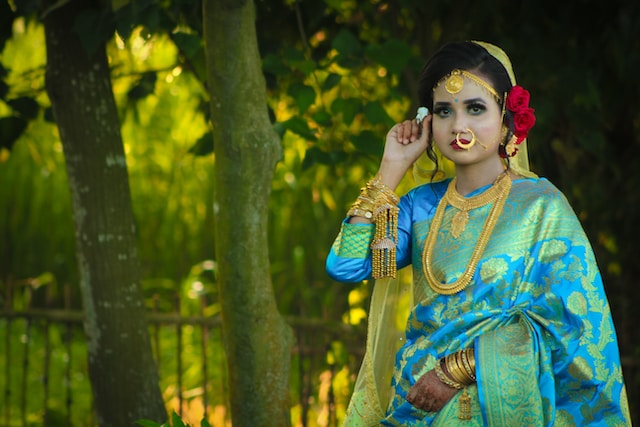Banarasi sarees hold a prominent place in the world of Indian textiles and are renowned for their opulence, intricate designs, and luxurious fabrics. These exquisite sarees trace their origins back centuries and have a captivating history that reflects the cultural and artistic heritage of the city of Varanasi, also known as Banaras.
Origins and Influences:
The history of Banarasi sarees can be traced back to the Mughal era in the 16th century. It is believed that artisans from Persia, who were skilled in weaving brocade and silk fabrics, migrated to Banaras during the reign of Emperor Akbar. Their expertise and techniques blended with the local craftsmanship, leading to the emergence of the unique Banarasi sarees.
Intricate Weaving Techniques:
Banarasi sarees are meticulously woven using a combination of silk and zari (fine metallic threads), predominantly gold or silver. The weaving process involves various intricate techniques, such as Kadwa (figured weave), Jangla (jaal work), Tanchoi (floating pattern), Vaskat (cutwork), and Tissue (exquisite metallic designs). These techniques require exceptional skill and precision, and the art has been passed down through generations of weavers.
Motifs and Designs:
The designs and motifs adorning Banarasi sarees are inspired by the rich heritage of Mughal architecture, nature, and folklore. The most popular motifs include intricate floral patterns, paisleys, intertwining vines, delicate leaves, and figures from epic tales like Ramayana and Mahabharata. The designs are typically large and bold, creating a visual extravaganza on the fabric.
Cultural Significance:
Banarasi sarees hold immense cultural significance and are considered a symbol of tradition, elegance, and grace. They are highly favored as bridal attire, particularly for weddings in North India, and are passed down as heirlooms from one generation to another. These sarees are also worn on festive occasions, religious ceremonies, and cultural events.
Geographical Indication (GI) Status:
In recognition of its historical and cultural significance, Banarasi sarees were granted the Geographical Indication (GI) status in 2009. This status ensures that sarees produced in the region of Varanasi and neighboring areas adhere to specific quality standards and carry the authentic Banarasi label.
Preserving the Legacy:
Over the years, Banarasi sarees have evolved to incorporate contemporary designs and cater to changing fashion trends, while still staying true to their traditional roots. However, the art of weaving Banarasi sarees faces challenges, including competition from power loom replicas and the diminishing number of skilled artisans. Efforts are being made by weavers’ cooperatives, government initiatives, and organizations to preserve this heritage craft and provide support to the weaver community.
The legacy of Banarasi sarees continues to enchant women across generations, reflecting the timeless beauty and rich cultural heritage of India.
